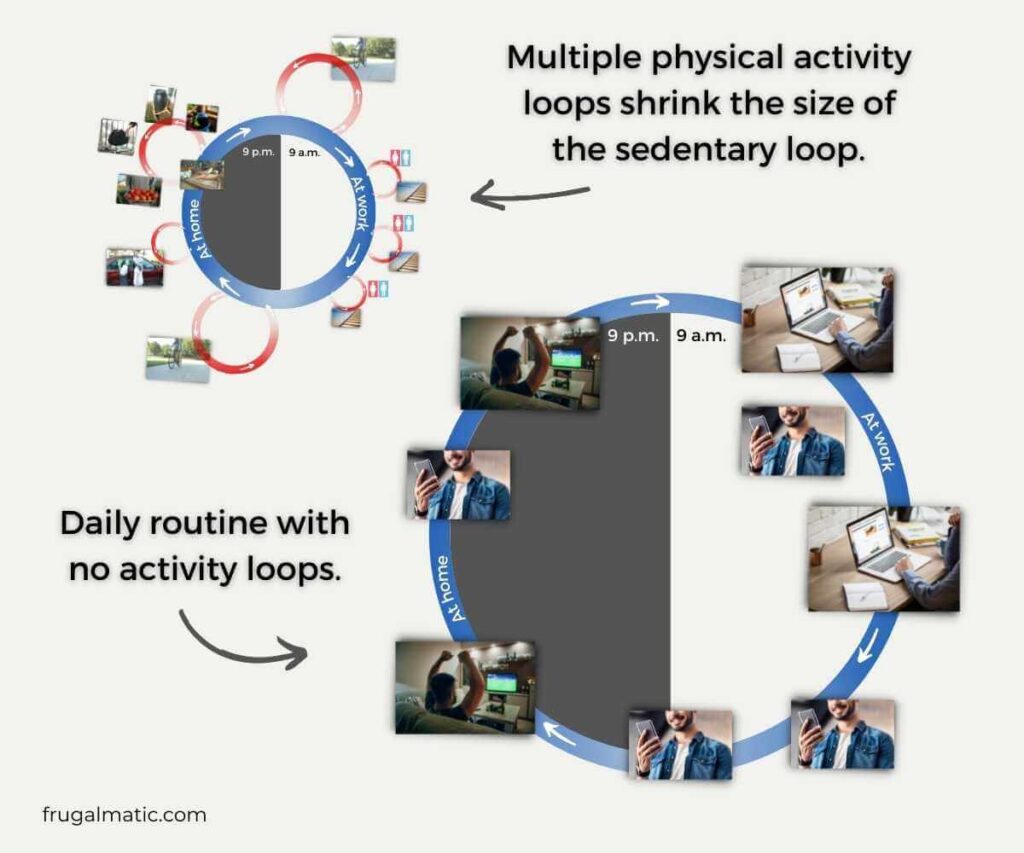This post was last updated on November 5th, 2022 at 02:09 pm
Our routines aren’t quite like Bill Murray’s in “Groundhog Day,” but they do tend to repeat themselves. Because our routines happen in a loop—over and over again—even seemingly trivial tasks can have big impacts over time. Just moving a few minutes every hour, for example, has been shown to have significant health benefits. Unfortunately, we live in a world that prizes sedentary behaviors, namely the heavy consumption of media through phones, computers, and TVs. To create a more active daily routine, we need to be intentional about how we set it up.
That’s why I’m a fan of adding small bursts of physical activity to my daily routine through what you might call “physical activity loops.” These loops are powerful because they’re continuous. When they become part of your routine, you don’t have to “think” about being physically active. It becomes almost-automatic. You can create these loops at home, at the office, or when we’re out and about. How you structure your loops depends on several factors, including your environment, your responsibilities, your physical capabilities, and your fitness goals.
Exercise is great. But it’s not always practical
If I had written this post 100 to 150 years ago, I’d probably get a lot of strange reactions. That’s because, back then, people’s daily routines required a lot of physical activity. For example, obtaining water often required pumping a well, while making food required jobs like churning butter and taking care of livestock. Even using the bathroom required a walk to the outhouse. People didn’t have to try to be physically active. They just were.
But with the industrial revolution, the United States and much of the world transitioned from physically active lifestyles to sedentary ones. Steadily, movement has been engineered out of our lives. Today, you can carry out your daily responsibilities, even grocery shopping, without getting out of bed, literally. The coronavirus pandemic has only accelerated this trend.
But here’s the thing: The human body evolved to be physically active, as many researchers, such as Dr. James Levine, have pointed out. Exercise is often touted as the solution. But the truth is, it can be difficult to habitually exercise because it doesn’t serve a practical purpose. Now don’t get me wrong—exercise is great. However, to have an active lifestyle, I believe it’s important to find ways to move throughout the day, not just during a workout.
To create a more active daily routine, get practical
This is where thinking of your daily routine as a series of loops can be helpful. One of the loops I’ve been developing over the past few years is what I’d call my “garden-to-table loop.” A sedentary routine often involves eating a lot of restaurant food, while a more active routine involves cooking at home. Plus, the food you cook is often a lot healthier than the take-out stuff.
I’ve long enjoyed home cooking, but I recently added another element to my loop: gardening. Thanks to the pandemic, my family rediscovered gardening after casting it aside for several years. We started up new plots in our backyard three summers ago. The vegetables we grow often go into our meals. Not all our food comes from our gardens, of course, but a big chunk does. This loop also includes the time and energy spent on preserving foods for use over the winter.
Read: Giving up your smartphone comes with big rewards
Finally, we maintain a compost bin, another physical activity. (And if you’re interested in making one, I recommend watching this Homesteadonomics YouTube video. I followed it in constructing our compost bin, with a few alterations. Works great!) We collect veggie scraps in our kitchen and then transport them to the compost bin. Then we add the compost to our garden. This isn’t an intense physical activity, but it does further expand my garden-to-table loop. Remember, it’s not just the intensity and duration of a physical activity that matters, it’s also the repetition.
What I love about this loop is it’s dedicated to producing something useful for our family: nutrients. Because it serves a practical purpose, it’s relatively easy to keep in my routine.


Choose activity loops that fit your circumstances
Now you might say, “But I don’t have time to do a garden and compost. What can I do instead?” Everyone’s routine is different, so I can’t say exactly what type of loop you should create, only that you should look for opportunities. Customize your own physical activity loops to match your schedule. Even if you spend a lot of time in an office, for example, you still have options.
When I worked in an office in a previous life, one of my favorite loops involved the restroom. Even though I worked on the second floor, I’d often use the restroom on the first floor to add extra steps to my day.
By the end of the day, I had taken several flights of stairs. And I didn’t walk casually. I tried to fly up and down those stairs, just to get the blood pumping a little faster. My former colleagues probably had no idea I was using the restroom to get some exercise because this loop fit seamlessly into my workday.
Indeed, these restroom jaunts became one of my most dependable forms of physical activity. Only my bike commute and brisk walks after lunch demanded more physical effort.
What else might you try? When I interviewed Dr. Levine about his approach to wellness, he talked about the benefits of walking meetings. Instead of meeting in a room around a table, he often discusses business with colleagues while on a walk. Each office environment offers different “loop” opportunities. You just have to identify one and do it!


Does your daily routine benefit or harm your health?
Our daily routines can be either our best friend or our biggest foe when it comes to our health. They can keep us in a sedentary rut, leading to weight gain while further re-enforcing sedentary behaviors. Or they can keep us perpetually active. It all depends on how we structure them.
Also keep in mind, the physically active daily routine is not all or nothing. The encouraging news is that you can be physically active in small ways, as I’ve tried to highlight in this post. Also, there’s no need to rush a lifestyle change. You can slowly add more activity loops into your routine. As you master your first physical activity loops, you can start adding others and expanding old ones.

